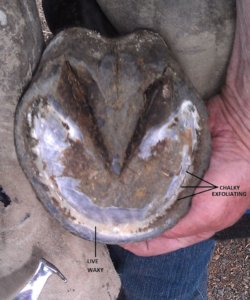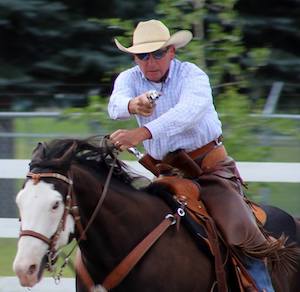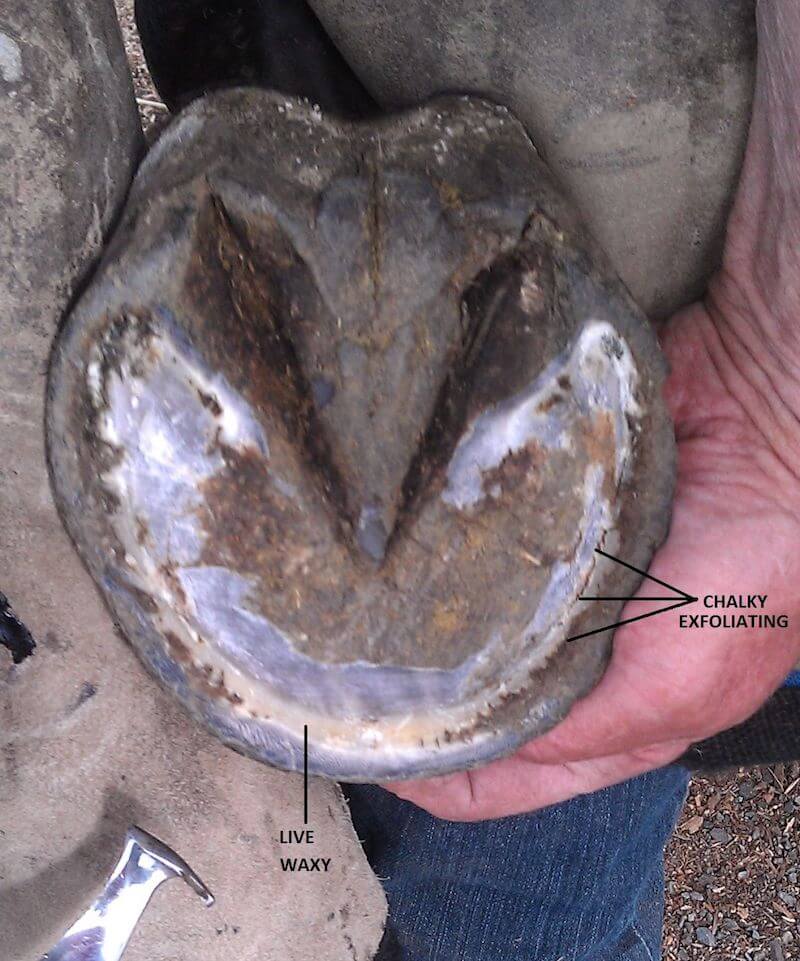Part 3: Understanding the Sole Plane
by Mark and Karen Plumlee, Mission Farrier School
Using the principles in this 5-part series will give you the basics for evaluating your horse’s hoof health. It includes: Understanding Foot Falls, Identifying Distortion, Understanding the Sole Plane, What is Breakover?, and Load Sharing. This month we cover the “sole plane” and the importance of properly balancing the foot.

The sole plane is the angle at which the sole sits within the hoof capsule. Hooves have an exfoliating sole plane and a live sole plane. The exfoliating sole plane is that chalky, flaky material that moves easily under the farrier’s knife. The live sole plane is the waxy, shinny sole, absent the chalk.
The sole plane is a reliable representation of the coffin bone plane. We use the sole plane as a reference to achieve medial/lateral balance. It mirrors the angle at which the coffin bone sits within the hoof capsule.
Identifying the live sole plane also keeps us “safe” and shows us where we can safely take our nipper cut without invading the sole. We remove the chalky exfoliating layer and we stop at the live waxy layer. We do not invade this layer with our knife.
Respecting the live sole plane is a better tool than using “thumb pressure.” Most of us were taught to carve out the sole until the sole “gave” to thumb pressure. When we could get the sole to move under pressure from our thumbs, that’s where we took our nipper cut. Not such a good deal for the horse. If I can make that sole flex to my thumb pressure, what is the coffin bone doing inside as our 1000 lb horse trots down the trail? We don’t want soles to “flex.” For that matter, we don’t want feet to flex. The equine hoof is designed to be harder than the environment in which he lives and works. A flexible hoof is a hoof that is already in trouble, and unfortunately due to environment, we see a lot of that in Western Washington and other irrigated environments. There is an entire movement out there that talks about the hoof “flexing” as if that’s a good thing. Flexible feet are not good. Blood is not “pumped” by flexing. But this is a subject that is best left for another article.
The foot reaches out to meet the ground in a manner that best suits that horse’s conformation of the limb, be that a good straight-legged horse, or one with angular limb deformities, pigeon-toed or toed out. Most of us were taught to site down the back of the limb, looking for the hoof wall to be perpendicular to the long axis of the limb. This just doesn’t work on most horses. To do this would assume that there are no joints in the lower limb, or that all horses are conformationally perfect. A better way is to trust our sole plane, trimming to the plane of the coffin bone. This will assure proper loading up through the coffin joint and will assure medial/lateral balance without over trimming the sole and making the horse sore. I’ve heard it said that “a horse doesn’t really get into his shoeing until 3 weeks after being shod,” as if owners should expect their horses to be sore after shoeing. Our opinion? If it takes 3 days or three weeks for a horse to recover from shoeing (or trimming), then we’ve done something TO the horse, not something FOR the horse.
If you try to trim the hoof wall at a right angle to the long axis of the limb, with no regard for conformation, this eventually creates a shift of the hoof capsule at the coronary band. The long term results of this approach to medial/lateral balance includes: sheared heels, quarter cracks, compromised vasculature and blood flow through the coronary band, reduction of sole density under the coffin bone, stress around the soft tissue of the coffin and pastern joints and unequal load on those joints which leads to deterioration of the articular cartilage. Although this is a traditional and commonly taught method to balancing a foot, and might be adequate on horses with perfect conformation and genetically good quality feet, most domesticated horses have some compromising issues. These issues are exacerbated by over-trimming the foot to achieve this medial/lateral balance. Excessive thinning of the sole under the farrier’s knife leads to chronic inflammation and a demineralization of the coffin bone.
In conclusion, trust the sole plane. That IS the reference to the coffin bone plane, no guessing. It will keep you from over trimming a foot, and since it mirrors the coffin bone plane, it’s more reliable than sighting down the back of the limb and you will be medially/laterally balanced to the skeletal structure within the hoof capsule.
Published October 2012 Issue

Mark Plumlee is a Certified Journeyman Farrier through the American Farriers Association, a Registered Journeyman Farrier through the Guild of Professional Farriers, and a Certified Barefoot Trimmer, Certified Farrier Practitioner and Certified Lameness Specialist through the Equine Lameness Prevention Organization. These diverse certifications speak to Mark’s commitment to the horse. Mark has published 6 educational DVDs and has been a pioneer in the advancement of farrier education for over 30 years. Mark, with his wife Karen own and operate Mission Farrier School and an Equine layup facility in Snohomish, Washington. They have graduated students from across the United States and 10 foreign countries. For more information visit http://www.missionfarrierschool.com and “Like” them on https://www.facebook.com/MissionFarrierSchool






